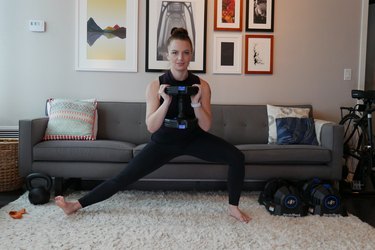
As a runner, you may prefer the open road to a stuffy gym. But to perform at your best on race day, you have to log some time in the weight room. Resistance training — which strengthens your muscles and joints — is a vital supplement to your roadwork, as stronger muscles mean more power for faster runs.
Video of the Day
Video of the Day
Why Runners Should Do Strength Training
"There's a saying that you need to be strong to run, but it's not actually running that makes you strong," says K. Aleisha Fetters, CSCS, fitness writer, trainer and coach, who explains that running primarily trains your muscles for endurance.
To build strength and power — especially in your hips and legs — you need strength training. "That's what's going to determine how hard you can drive into the ground to spring forward with each stride and how fast you can turn over," Fetters says.
Plus, building strong muscles and joints can help prevent running-related injuries. Since running is a repetitive sport — which focuses squarely on forward movement — "some muscles are working constantly while others are altogether neglected," Fetters says, explaining that this scenario "sets runners up for a host of different injuries."
For example, two of the most underused muscles in running, the gluteus medius and gluteus minimus — located on the upper side of your butt/hip — often become weak, leading to muscular imbalances, which can cause chronic problems and pain in the IT band (an elastic connective tissue that runs down the outside of your thigh) and knees.
When it comes to building strength, especially in these neglected muscles, unilateral (single-leg, in this case) exercises are the way to go. That's because, when you're running, you're never on both feet at the same time. "When strength training to improve your performance, always think about the carryover," Fetters says. "We call this picking sports-specific exercises."
To that end, choosing strength-based exercises with a plyometric focus is also a smart strategy for runners who want to increase power and speed. Since plyometric moves train your muscles' elastic properties to absorb and quickly generate force, they help prepare your muscles for the explosive movements (bounding off one foot at a time) involved in running, Fetters says.
Try This 20-Minute Strength-Training Workout
This 20-minute strength routine from Fetters incorporates lower-body moves with plyometrics that'll help you build muscle and PR at your next race. Rather be outside? No sweat, this workout can be performed anywhere. Just grab a resistance band and set of weights and head outdoors.
Warm-Up
Do: 3 to 5 minutes of light cardio (walking, jumping jacks, high knees, etc.) and dynamic stretches
The Workout
Note: Performing this routine as a circuit would let you get more done in less time, but the sets/reps/rest scheme is designed specifically for increasing power and strength.
Move 1: Plyo Lunge
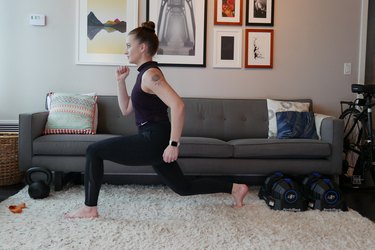
- Stand with your feet shoulder-width apart.
- Step forward with your right foot, then lower until your right thigh is parallel to the floor and your back knee almost touches the ground.
- Drive through your feet, exploding up as high as you can, alternating legs in the air so you land with your left leg forward.
- As you land, sink down into the lunge and then explode back up, switching legs again.
Reps: 3 sets of 3 to 5 reps per side, resting 90 seconds to 2 minutes between sets
Move 2: Banded Side Plank to Clam Shell

- Loop a resistance band just above your knees.
- Lie on your side, positioning yourself on your bottom elbow, which should be directly beneath your shoulder.
- Bend your knees so that your feet and lower legs are behind you.
- Lift your bottom hip off the ground, driving through your bottom knee and forearm.
- Squeezing your glutes, lift your top knee toward the ceiling. Pause at the top of the movement, then slowly lower your body back to the floor.
Reps: 3 sets of 8 to 12 reps per side, resting 30 seconds between sets
Move 3: Single-Leg Deadlift
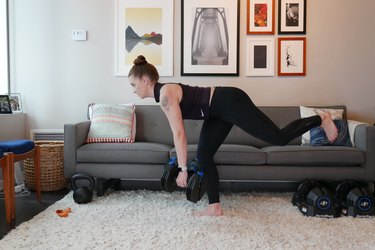
- Start with your right foot planted as your anchor leg, holding a dumbbell or kettlebell in each hand.
- While keeping a slight bend in your right knee, raise your left leg straight behind you as you hinge at the hips to bring your torso parallel to the floor (and lower the weight toward the floor). Think of moving your body in a seesaw motion: you hinge at the same rate that you lift the leg behind you.
- Your hips should stay square throughout the entire movement, avoiding the tendency to turn them out.
- Keep your back flat. At the bottom of the movement, your torso and left leg should be almost parallel to the floor with the weight a few inches off the ground.
- Keeping your core tight, push through your right heel to stand up straight and squeeze your butt. As you do, keep the left leg straight and bring it back toward the starting position.
Reps: 3 sets of 8 to 12 reps per side, resting 30 to 90 seconds between sets
Move 4: Lateral Squat
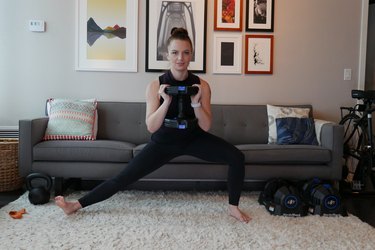
- Stand with your feet together, holding a dumbbell vertically at your chest.
- Take a large step to one side. Your foot should land double shoulder-width apart. Bend your knee and push your hips back as you lower into a lateral lunge.
- Keeping your torso vertical, drive off your bent leg, push through your heel and return to the starting position. Then continue on opposite leg.
Reps: 3 sets of 8 to 12 reps, resting 30 to 90 seconds between sets
Tip
For a greater range of motion, let the balls of your straight leg's foot raise from the floor with each rep.
Move 5: Single-Leg Glute Bridge
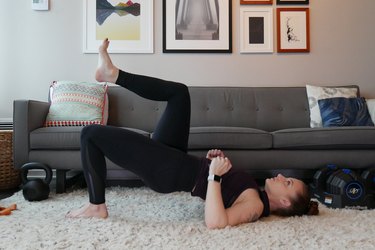
- Lie flat on your back with your knees bent to 90 degrees and your feet 6 to 8 inches from your glutes.
- Lift one leg off the ground, then drive through your heel to lift your hips up until your body forms a straight line from shoulders to knees.
- Pause, squeezing your glutes at the top of the movement.
- Slowly lower your hips to the ground.
Reps: 3 sets of AMQRAP (as many quality reps as possible) per side, resting 30 to 90 seconds between sets
Check out more of our 20-minute workouts here — we’ve got something for everyone.